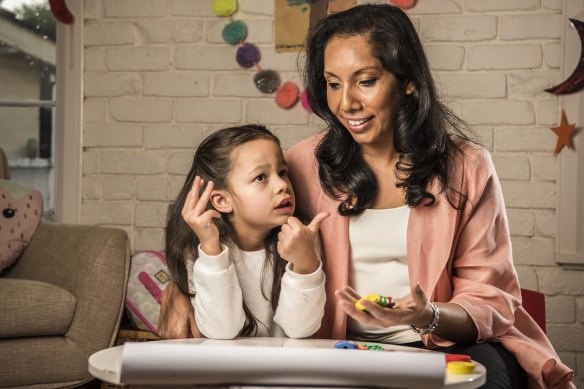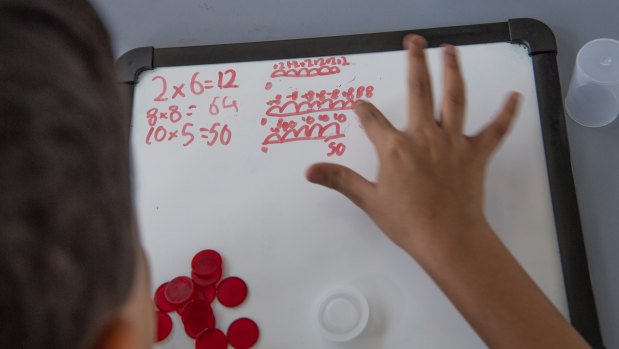By Jordan Baker
YouTube is rich with awkward attempts by parents and teachers to shoehorn times tables into pop songs. The chorus of Taylor Swift’s Shake it Off has become a six times table song, and Katy Perry’s Firework has been commandeered for the sevens. Some parents hope home-made hip hop will cement the numbers in little heads, alongside more traditional methods such as a chart on the toilet door or chanting in the car.

Andrea Christie-David and her six-year-old daughter Anneke Ferry. She is teaching her daughter times tables because she thinks it’s important to know them off by heart. Credit: Steven Siewert
University of NSW educational psychologist Professor John Sweller has bad news for anyone seeking shortcuts to help their kids memorise their times tables, or, as he calls it, “automating” them. There’s no silver bullet; only one approach is truly effective. “If you’re going to automate information, you need to practise it … and practise it to the point where you no longer have to think about it,” he says.
Times tables get a bad rap these days. They’re synonymous with rote learning, which makes many primary teachers and parents shudder. Understanding how numbers work is now considered more useful than parroting them like robots.
Yet high school teachers say knowing the times tables - or, in education parlance, multiplication facts - by heart is essential to secondary maths, and too many students arrive in year 7 without having mastered them. “We see very little fluency,” says one, on the condition of anonymity because he is not authorised to speak to the media. “Which is where the coaching colleges are filling the void, whether we like it or not.”
Eyebrows shot up in some secondary maths departments when a draft of the new national maths curriculum was made public in April, and one of the proposals was to shift times tables from year 3 to year 4 (year 3 students would just focus on multiples of two, three, five and 10, rather than all of them). It also delayed linear equations (such as x + 3 = 11, so what is x?) by a year, and cut algebraic terms such as ‘polynomial’ . Critics worry that in attempting to make maths more accessible, the curriculum is making it less mathematical by diluting and delaying the content. One teacher described it as a “dumbing down”.
But others say maths needs to change, and that it’s no longer enough to learn about number facts and equations; students must also understand how to use what they know in the world around them. As the reading wars settle - in NSW, at least - the maths wars are erupting over similar issues, as traditionalists and progressives argue about what students should know, and the best way to teach them.
Australia has a maths problem in its schools. The performance of the country’s students has steadily declined since global maths literacy tests began almost 20 years ago. By 2018, Australian 15-year-olds were a year behind where the same age group was in 2003, and three years behind those in the top-performing country, Singapore, when tested on how they apply the maths skills they’ve learnt. Amid the hand-wringing that followed the latest results (in late 2019), education ministers pointed to the revision of the national maths curriculum as their solution.
But curriculum is just one piece of the puzzle. Australia has a chronic shortage of maths teachers; one in four year eight students is taught by someone who was not trained in the subject, compared with one in 10 internationally, and the least experienced teachers tend to end up in the schools where expertise is most needed.
The country also has a maths confidence problem, which extends to teachers, too. “We know that a high proportion of primary teachers don’t like teaching maths, they’re not confident in teaching maths, and they don’t necessarily teach it well,” says Sue Thomson from the Australian Council for Educational Research.
Curriculum is nevertheless important. It’s a statement of the knowledge, skills and standards Australia expects for its children. Both sides of the maths wars agree the existing curriculum isn’t great - it has been described as repetitious, unambitious, disconnected and lacking in critical elements - so the Australian Curriculum, Assessment and Reporting Authority’s review was designed to prune, clarify and update it. ACARA says the resulting draft emphasises exploration, experimentation and reasoning, and many of the other so-called 21st century skills educators say students need for an uncertain future, such as problem solving and creative thinking.
The proposed curriculum changes have strong backing from some educators. In April - before the draft was made public - a group of maths organisations, including the Australian Association of Mathematics Teachers (AAMT) and the Australian Mathematical Sciences Institute, issued a joint statement saying that teaching straight maths was no longer enough. “The abilities to problem-solve, mathematise, hypothesise [and] model are all skills that add worth to acquired knowledge,” it said. “Mathematics learning cannot sit in silos that focus on content and procedures. Instead, it must be something that gives the knowledge purpose.”
AAMT chief executive Allan Dougan said maths knowledge was important, but “then there’s the next step, which is what [students] do with that. It’s about us looking at how we equip our young people to go out and be effective users of maths in the 21st century ... not every young person will be a mathematician.”
However, another group of mathematicians, academics and maths teachers wrote an open letter to ACARA last week criticising the changes. It said the draft devalued basics such as times tables and introduced vague, untested fads such as “mathematising”, which involves explaining a real-life experience in mathematical terms, such as a game of putt putt golf in scores and angles. The letter was particularly critical of suggestions for problem solving in the draft, which it criticised as unsolvable and of questionable teaching value. The signatories called on ACARA to dump the proposed changes and begin a “proper and properly open” review, which involves mathematicians.

Success story: ACARA examined Singapore’s curriculum as part of its research and points to it as a model for its focus on problem solving.Credit: Getty
“There’s a big difference between experts in maths education, and mathematicians,” says Greg Ashman, one of the signatories, who is the head of research at Ballarat Clarendon College and a PhD candidate at the University of NSW. “This has been designed by experts in maths education, and they have very different ideas. People are always trying to debase the currency of maths. Maths is challenging, and when we sell it to primary school kids - and often the teacher is not a maths specialist - we sell it to them on its usefulness. Somehow that will get them to engage. We don’t do that to other subjects.”
Another signatory to the letter was Peter Brown, a highly-regarded maths educator-turned-lecturer at UNSW. “I used to run maths clubs all over Sydney, I did [that kind of] problem solving with the best and brightest, and it’s difficult,” he says. “They give them open-ended questions that are ill-posed, which leads to confusion and frustration. You [should] teach a piece of mathematics properly and well, then you look at the applications. I get the sense that they are trying to devalue mathematical fluency.”
Eastern suburbs mum Andrea Christie-David says she is already working on number facts with her six-year-old daughter. “I can absolutely see why it’s important, because of abstract reasoning, mental maths and problem solving,” she says.
“There’s so much reinforcement required - you’ve really got to reinforce those core principles. I’ve found that visual cues are really useful. Then it makes it more fun. It gives them confidence, too. Confidence is really crucial. It’s allowing them to say, “I’ve got that skill, I can move forward’.”
But in an age of calculators and Google, many parents assume that children no longer need to be fluent in maths facts. Achieving that fluency can be boring - although it doesn’t have to be. But as Sweller’s research has found, it’s important. Humans have a working memory, which can process a small amount of new information, and a long-term memory, which is a vast library of knowledge collected over years. If key number facts cannot be instantly recalled from that library by high school, the student will devote so much of their working memory to figuring them out, or to faffing about with a calculator, that they will not have enough left to process the new, harder material. Or, as Brown puts it, “you can’t be trying to do complex maths and scratching your head about three times five”.
Sweller argues that a failure to ensure students leave primary school having mastered fundamentals is “not part of the problem [of Australia’s declining results in maths],” he says. “It’s the entire problem. They’re not learning number facts. They can’t read properly. The suggestion that the 20th or 19th century people didn’t need to think critically is just ridiculous. Nothing has changed in the 21st century that we didn’t need as much in the 20th or even the first century. In fact, they probably needed to do more problem solving in the first century.”
ACARA says students will still become familiar with patterns and some multiplication facts in year 3, and some teachers say there’s not much difference between years 3 and 4 (the NSW curriculum considers the two year-groups a single ‘stage’).
But Ashman says Singapore’s curriculum - which ACARA examined as part of its research, and points to it as a model for its focus on problem solving - expects students to ‘master’ their times tables in its equivalent of years 2 and 3 of primary school. “We can reasonably ask the question: How can we be sure that Singapore’s higher performance than Australia ... is caused by a focus on problem solving rather than, say, Singaporean students knowing considerably more maths?” he says.

The performance of the country’s students has steadily declined since global maths literacy tests began almost 20 years ago.Credit: Louise Kennerley
Another secondary maths teacher, again speaking on the condition of anonymity, says one key problem sat outside the curriculum; primary teachers did not understand the importance of number fact fluency to high school mathematics, and have never been taught effective drills. “The fad … is very prevalent in primary; that we don’t need students to do drills, they just need to understand,” he says. “With teachers at primary level not necessarily having the right philosophical outlook of getting the right balance of drill v non-drill activities, you can change the syllabus as much as you like, but if they’re not going to be setting more drill-type work, the primary students in the state will do as little as they can in mathematics.”
Kim Beswick was a high school maths teacher for 13 years, and led the AAMT before becoming a professor in maths education at UNSW. She says the proposed changes to the curriculum are not dramatic, and do not “warrant the angst expressed in the letter”.
Every teacher she has ever met appreciated the importance of number facts, and there will always be disputes over curriculum. This fight distracted attention from a much bigger problem. “If you don’t have a confident maths teacher in front of you, they’re not going to convey the spirit of the curriculum,” she says. “It’s easier to write a curriculum than it is to alter the workforce. There are schools that don’t have a single, properly-qualified maths teacher.”
NSW has its own curriculum, which “aligns” with the national one. It is being re-written by the NSW Education Standards Authority, and will be taught from 2024. “Within NSW circles,” says one maths teacher, “our question is how much will NESA then tinker with the Australian curriculum?” A spokeswoman for NESA said NSW took an “adopt and adapt approach” to the Australian curriculum. At present, times tables were introduced in year 3. “Evidence-based reform of our own NSW syllabuses is well underway,” she said. “These reforms will ensure students have built the foundational skills they need in maths before applying them to solve problems.”
The Morning Edition newsletter is our guide to the day’s most important and interesting stories, analysis and insights. Sign up here.